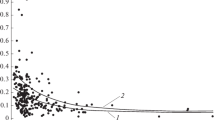Abstract.
—The dynamic loads imposed by rockbursts initiated by remote seismic events are directly related to the resultant ground motions. Consequently, the first step in the design of systems for the support of openings subject to such loading is to assess the ground motion characteristics; i.e., to evaluate the peak particle velocity ppv in the design region. Design scaling laws, relating seismic source intensity (event magnitude, radiated energy or a combination of seismic moment and stress drop at the source) to the peak ground motion characteristics at a target (e.g., a development drift or a stope) some distance from the source, are developed, based upon theoretical considerations and supported by a world-wide database. These scaling laws reflect the most relevant, critical conditions for engineering design.
Similar content being viewed by others
Author information
Authors and Affiliations
Additional information
Received December 23, 1996, accepted June 26, 1997
Rights and permissions
About this article
Cite this article
Kaiser, P., Maloney, S. Scaling Laws for the Design of Rock Support. Pure appl. geophys. 150, 415–434 (1997). https://doi.org/10.1007/s000240050085
Published:
Issue Date:
DOI: https://doi.org/10.1007/s000240050085




